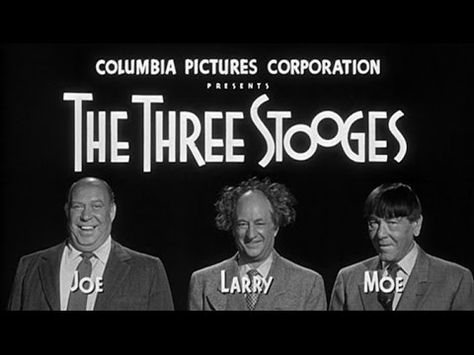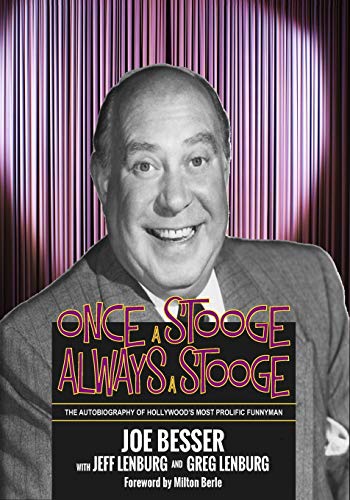This is one of my favorite random “SImpsons” bits:
Of course, the actual “very late Three Stooges” shorts…the final batch produced at Columbia Pictures in 1955 and 1956, featured Larry, Moe, and Joe Besser.

I just finished a pretty lengthy autobiography that, in its initial printing in the early 80s was called “Not Just A Stooge.” The reprinting has a more pragmatic title:

The Lenburg brothers, listed here as co-authors, asked to interview Joe Besser for a school assignment, and that led to a friendship and partnership that lasted for the rest of Besser’s life. The book they have created is a fantastic account of a pretty darn remarkable career.
The majority of the book covers live stage work, primarily vaudeville shows in which Besser honed his juvenile stage persona. His first gig was assisting a magician, and getting laughs by fouling up his role as assistant. Besser met and worked with a variety of big names in his vaudeville years, including Sammy Davis Jr. and Donald O’Connor when they were kid performers.
Vaudeville opened doors to Broadway revues including a long run with Olson and Johnson, whose fast-faced comedies included “Hellzapoppin'”. (Checking Google for the correct spelling of “Hellzapoppin'”…looks good.) Eventually Besser got signed to Columbia Pictures where he made several 1940s comedies.
I found quite interesting a sequence involving Jack Benny inviting Besser to guest on his radio program. Besser was extremely nervous and hesitant to do the guest spot, to the point of wearing his stage costume to the broadcast. Besser confesses that he was actually booked to be a guest on another radio program years earlier and simply didn’t show up, as he was too consumed by mic fright. (I’ve seen mic fright in person many times…it is difficult for me to comprehend because talking into a microphone is just about the only thing in the world that doesn’t scare me.)
Following the Benny appearance Besser felt more confident about radio and was heard on programs hosted by Fred Allen, Milton Berle and others. Besser was a participant in “Hour Glass”, one of the earliest network television broadcasts…and went on to make guest appearances on a variety of comedy/variety shows and even some dramatic programs.
Of course, Besser’s best-known role may very well be that of “Stinky”, Lou Costello’s frenemy on season one of “The Abbott and Costello Show.” The book reveals that Besser first performed the complete character–Little Lord Fauntleroy outfit and all–on “The Alan Young Show”, starring the future caretaker of Mr. Ed. It was Lou Costello who suggested the name “Stinky”.
Following his one year with Bud and Lou was his brief run as the third stooge. Besser details his conversations with the director of the shorts about not having to do anything that would cause him injury. All of the other Stooges had harrowing stories of malfunctioning props and other catastrophes.
I would say the Stooges shorts with Besser are largely considered the weakest of the bunch. But that has less to do with Besser and more to do with a variety of other factors. The Besser shorts had slashed budgets (by 1955 most movie theaters weren’t booking two-reel comedies anymore) and by this time the Stooges suffered from sheer exhaustion of every comedic premise. Many of the shorts reused mass quantities of footage from previous shorts, either for budgetary reasons, lack of a new idea, or both.
By 1961 Besser was in something of a career slump. Joey Bishop to the rescue!
“The Joey Bishop Show” premiered in 1960 as a sitcom about an inept underling at a talent agency whose family relies on him to bring home the bacon. By the end of the first season Bishop had started casting Besser in small parts as neighborhood figures like a postman. In the hiatus between seasons one and two, the series was completely revamped. Joey Barnes was no longer a nebbishy low-level talent agent; he was now the rich, popular star of a late-night TV talk show! Somebody like…you know…Joey Bishop. His needy family was never heard from again. His beautiful new bride was a Texan played by Abby Dalton. And the super of their posh uptown apartment building was Jillson, played by…Joe Besser.
Jillson is probably my favorite of Besser’s roles. Besser notes throughout the book that he has always enjoyed playing fast and loose with scripts, tossing in ad libs and extra business. You can kind of tell when it’s happening on “The Joey Bishop Show.” Watch Abby Dalton:
“The Joey Bishop Show” has always fascinated me because it’s got such an unusual history. The first season (with the needy family) aired in black and white on NBC. The 2nd and 3rd seasons aired “in living color” on NBC. The 4th (and ultimately final) season found the show moving to CBS, a network that–unlike NBC–did not own a company that sold color TV sets. So CBS aired the 4th and final season in “financially preferable black and white.” I’m pretty sure that makes “The Joey Bishop Show” the only prime-time series that went from color to black and white.
The other thing I find fascinating about “The Joey Bishop Show” is that virtually everyone who worked on it or appeared on it had nothing good to say about Joey Bishop. He is notorious in that regard. So I will point out that while Besser is genuinely thankful to Bishop for getting him a well-paying, high-profile regular gig, he does not get anywhere near the subject of what it was like to work with Bishop. (Besser is effusive in his praise of fellow co-stars Lou Costello, Moe, Larry, Olson, Johnson, Carmen Miranda, and many others.) So take that for what you will.
The book concludes with a discussion of Besser’s animation voice-over work (the genie in Hanna-Barbera’s “Jeannie”? The one who went “Yapple-Dapple”? Anyone?) and the role Besser played as Last Of The Stooges, particularly his unforgettable experience speaking at the ceremony for the Three Stooges’ star on the Hollywood Walk Of Fame.
“Once A Stooge, Always A Stooge” is a fascinating account of every aspect of 20th century show business…from vaudeville to Broadway, radio to television, feature films and shorts. Joe Besser was a unique talent and it’s fun to read about his journey.
